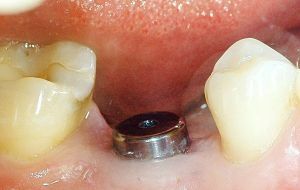 The shaper for the gum is a strong metal piece that is needed to properly form soft gum tissue around the implant tooth.
The shaper for the gum is a strong metal piece that is needed to properly form soft gum tissue around the implant tooth.
This component is used before installing the dental crown or prosthesis. It is screwed into the installed implant( artificial root of the tooth) and helps tightly fit the prosthesis to the gum and look more aesthetic.
Installation of the gingiva former is an intermediate step in the course of dental prosthetics. Its main purpose is to prepare a place for the installation of the crown and to form a natural contour of the edges of the gums surrounding the implant. The installation of this design helps the soft tissues to acquire the necessary volume and completeness to create a natural form.
The setting of the gum shaper is especially important when implanting the front teeth, which are clearly visible when smiling or talking.
content
- Appearance
- Materials for
- difference from the abutment
- each Opportunity
- installation process
- Soreness procedures and possible complications
- Further stages prosthesis
- Error
- care and hygiene After installation
- cost of installing
Appearance
upper portion of the articlerepresents a cylinder, which corresponds to the size of the prosthetic tooth. With the help of a thread, the shaper is screwed into the installed root implant and fixed securely.
The dimensions and shape of the construction are carefully selected according to the future dental prosthesis( crown).The thread is cut very tight, which provides additional strength and stability to the joint. The appearance resembles a metal bolt, which repeats its natural contour shape.
Materials for manufacturing
The product is made of high-quality and extra-strong materials. The most common and traditional metal for this is titanium. Its advantage is its special strength and corrosion resistance, also titanium has the ease that allows to exclude unnecessary strain on gum tissue and root prosthesis.
The disadvantage, which essentially limits its use, is the transmission of the titanium shaper through the gum, which does not look very nice and spoils the appearance, especially of the front teeth. Also shapers are made of zirconium. Used and cheaper materials, inferior in strength, for example, ceramics and plastics.
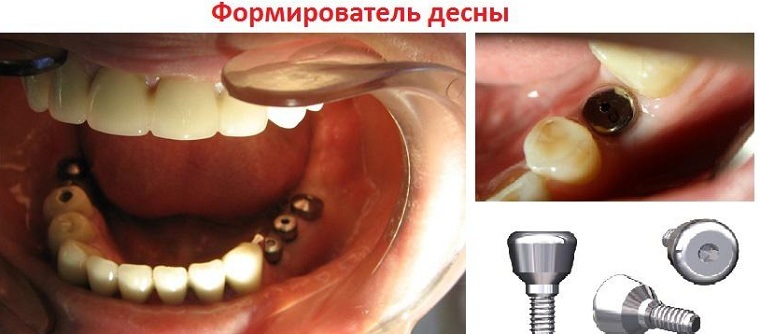
Difference from the abutment
The gum formulator is often confused with the abutment, although, by and large, they are them. This product connects the root prosthesis with an artificial tooth. It is attached when the gum form is already formed, and gives increased strength to the entire prosthesis design.
The upper part of the part can be different and selected individually for the crown. It can be standard or temporary. The use of the shaper precedes the anchoring of the abutment.
The material used for the manufacture of products - titanium, zirconium, ceramics or plastic, as well as their combinations.
To each according to the possibilities
Different types and forms of products are produced. All formers are divided into three classes:
- economy ( manufactured in Israel, Korea);
- business ( manufactured in Germany, Israel);
- premium ( manufactured in Switzerland, Sweden).
It is clear that such a classification is based on the principle of the ratio of price and quality. All products differ in their composition, the raw material. They have a phase shape and type of thread, as well as manufacturing techniques.
The following manufacturers are in demand: NSK( Japan);Alpha Bio, Adin( Israel);Bicon, Nobel Biocare( USA);Astra Tesh( Sweden);Semandos, Nico, Impro( Germany).
Installation process
Setting the shaper is considered a micro-operation. The procedure is simple, especially for an experienced professional.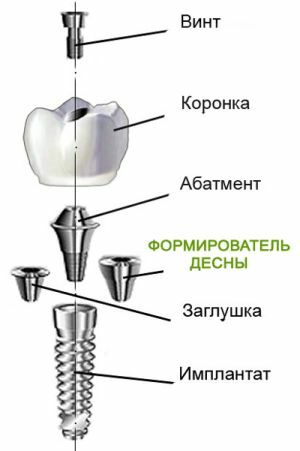
The root implants of modern models have a special socket for screwing the gingiva former. It can be installed in two ways. Simultaneously, that is, immediately after fixing the root implant, the shaper itself is screwed into it. Normally, this is done after some time, when the root prosthesis is overgrown with a soft cloth and will settle into the jaw bone.
Generally, the gum base product is inserted after several months( 3-6) after the implant is implanted. The operation does not last long and includes successive steps:
- local anesthesia( anesthetic injection in gum tissue);
- small incisions of soft gum tissues in the area of overgrowing for the possibility of fixing the shaper in the implant;
- clipping of excess gingival surface tissues;
- removal of the plug from the root prosthesis;
- setting the shaper in the implant( screwing);
- application of stitches to tighten wounds and accelerate healing.
The procedure lasts about half an hour.
For the curious: setting up the gingiva shaper and the entire implantation process can be seen step by step on the photo and video materials:
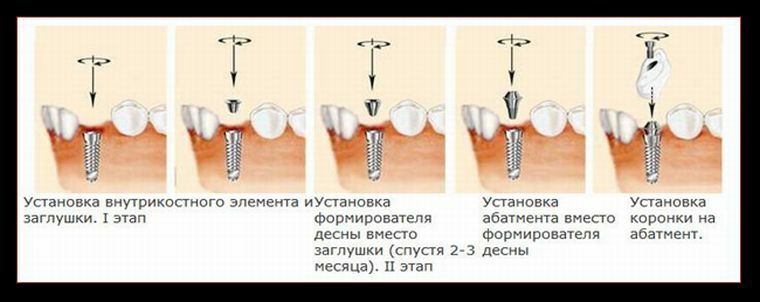
The soreness of the procedure and possible complications
Thanks to the local anesthesia, the pain is almost not felt. After the end of anesthesia, discomfort and pain may occur, which is the norm, if their duration is not more than a week. It all depends on the adaptation of the body and the healing speed of soft gum tissue. There may be bleeding gums.
The main complications that can develop after the installation of the gingiva former. Are considered:
- prolonged bleeding gums and sutures;
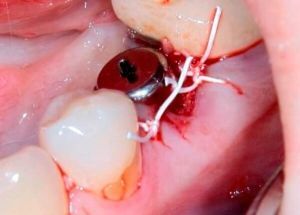
- appearance of puffiness in the gum area, which does not subside for a long time;
- the onset of an allergic reaction of the body, which, as a rule, arises from anesthesia;
- prolonged pain and the appearance of a tumor in the area of the root prosthesis, throat or neck;
- difficult swallowing, numbness of the tongue, lips or cheeks with injuries of nerve endings;
- possible rejection of the implant( it staggers).
For any complications, the specialist must establish the cause and prescribe the treatment.
Further stages of prosthetics
Restoration and healing of gingival tissue proceeds gradually. The process takes about 7 - 10 days. In the root prosthesis the shaper is located before the complete healing of the tissues, the formation and formation of uniform upper edges of the gum.
The exact timing of the shaper in the implant is determined by the dentist, depending on the development of the healing and overgrowth process.
Then the driver is carefully unscrewed and in place an abutment is mounted on which the crown( an artificial tooth) is fastened.

Possible errors
The quality of screwing in and fixing the driver directly affects the success of further prosthetics.
The installed part looks like a metal cap that rises above the gum a few millimeters. If it is installed correctly, side effects in the form of discomfort, irritation, inflammation and allergy will be absent.
The fixation is not performed properly if the following occurs:
- gum tissue partially or completely covered the gingival cap, this may occur due to incorrect fitting of the part size;
- of the product staggers or falls out, the cause is a loose fit to the root implant;
- incorrectly selected the height of the part, in this case the long construction interferes with bite and chewing.
The dentist should correct the errors. He twists or replaces the shaper. The part can be unevenly installed. It is important that the root implant is correctly installed and the angled abutment eliminates inaccuracy. If there is an accelerated overgrowth of the gingiva former, excess tissue is cut off surgically. The main thing is not to mix hyperplasia with swelling of the gums.
Care and hygiene after the installation
 After the operation, the recovery process is largely dependent on compliance with the rules of oral care. In the first days after the procedure, it is advisable to eat warm, rubbed food, or to smoke, or to drink coffee and fizzy drinks.
After the operation, the recovery process is largely dependent on compliance with the rules of oral care. In the first days after the procedure, it is advisable to eat warm, rubbed food, or to smoke, or to drink coffee and fizzy drinks.
Rinse the mouth after each meal. It is necessary to limit physical activity for the near future. If medications have been prescribed, then they should be taken strictly according to the scheme for the entire prescribed period. Daily oral hygiene provides:
- gentle brushing of teeth using a soft brush twice a day;
- selection of a special therapeutic toothpaste;
- mouth rinses with herbal decoctions or special rinse aid.
The use of medicinal herbs, which have antiseptic and anti-inflammatory properties, accelerates the healing process. For rinses use decoctions of chamomile, calendula, sage. Medicines can be prescribed: antiseptics, anti-inflammatory, healing.
Cost of installation
The total cost of installing the shaper, as a rule, includes the price of the structure and the costs of the operation itself. 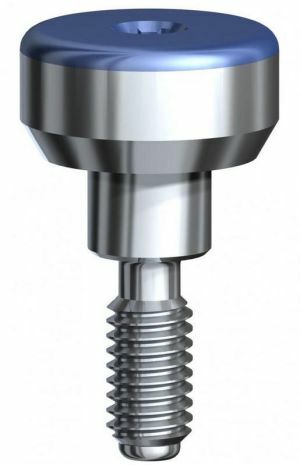
The cost depends on the product class( economy, premium or business).
Also, the difference in cost is due to the manufacturer, the price of the raw material, the dimensions of the part.
The final cost depends on the degree of complexity and volume of the procedures performed. The lowest cost of products from Israeli manufacturers. The total price with installation from 1500 - 1100 rubles. The price of the formers themselves is from $ 15 and above.
Using the shaper can not be underestimated, so that the result justifies all expectations, you need to go through each stage of implantation.
